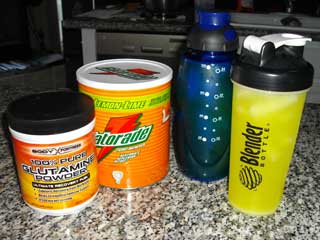There may come a day in the life of an active exerciser that mere water is just not good enough hydration anymore. That’s what sports and “recovery” drinks are supposed to be all about. You won’t need G2 for a brisk walk around the block, but for a marathon? For exercise that gets you into the upper end of the aerobic workout “zone” and keeps you there for most of an hour, or more? This post is for you.
 Honestly, we’re fans of good old fashioned powdered Gatorade. It’s one of a handful of sports beverages that occupies the sweet spot of between 6-8% carbohydrates. Below 5%, and you don’t get enough energy. Over 10% (as in fruit juices or colas), and you risk intestinal cramps, nausea, diarrhea, and impaired absorption. It also has at least 100 mg of sodium per serving, so that fluid is more likely to stay in your system [ACE Personal Trainer Manual, Third Edition, p 141]. At only 50 calories per scoop, it’s diet friendly even without resorting to the lower calorie version. Although each scoop theoretically makes 8 oz, we don’t use it full strength. It’s even budget friendly in the “dust” form. And think about it, what sports drink do you see at all the big games? Do you suppose the professional coaches know what they’re doing?
Honestly, we’re fans of good old fashioned powdered Gatorade. It’s one of a handful of sports beverages that occupies the sweet spot of between 6-8% carbohydrates. Below 5%, and you don’t get enough energy. Over 10% (as in fruit juices or colas), and you risk intestinal cramps, nausea, diarrhea, and impaired absorption. It also has at least 100 mg of sodium per serving, so that fluid is more likely to stay in your system [ACE Personal Trainer Manual, Third Edition, p 141]. At only 50 calories per scoop, it’s diet friendly even without resorting to the lower calorie version. Although each scoop theoretically makes 8 oz, we don’t use it full strength. It’s even budget friendly in the “dust” form. And think about it, what sports drink do you see at all the big games? Do you suppose the professional coaches know what they’re doing?
While Gatorade has the carbs and electrolytes handled, it does not contain any protein whatsoever. That’s a shame, because even Gatorade’s scientists admit that a little bit of extra protein can aid glycogen resynthesis under the right circumstances, and “produce a transient, net positive increase in muscle protein balance.” They cite research from the 1990s showing that “specific amino acids such as glutamine and possibly arginine may influence post-exercise glycogen resynthesis to a surprising extent, particularly in the absence of CHO [carbohydrate] intake.” There’s a lot of research showing that just a very small amount of protein reaps huge benefits.
Specifically, glutamine has been shown to have beneficial effects on how and where the body stores glycogen and carbohydrates, particularly when taken with some carbohydrates. Glutamine is available in supplement stores and in the vitamin section of some large retailers. It may seem pricey until you realize that just a teaspoon is one serving. That container will last for quite a while!
So our optimum, budget friendly recovery drink is 2 scoops of Gatorade dust for 100 total calories, 1 teaspoon of glutamine for 15 calories, in a one liter bottle filled with half ice and half water. Sometimes we will go through the whole bottle over the course of a really tough workout, and sometimes we won’t. It’s more fiddly than some of the factory balanced recovery beverages out there but compared to our mix the costs of those are astronomical.
One further note, there’s a definite difference between the powdered Gatorade and the premixed bottles of sports drinks at the convenience store. The premixed bottles very often are sweetened with fructose instead of granulated sucrose. We’ve been over the negatives of fructose before. Stick with the powder on this one.




Hi, cool blog and informative post… Thank you!